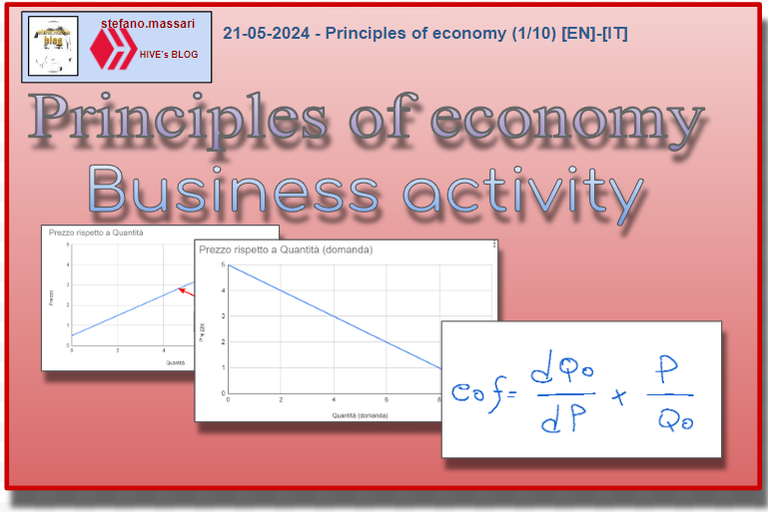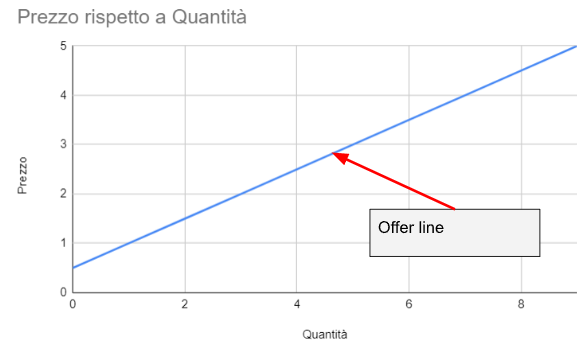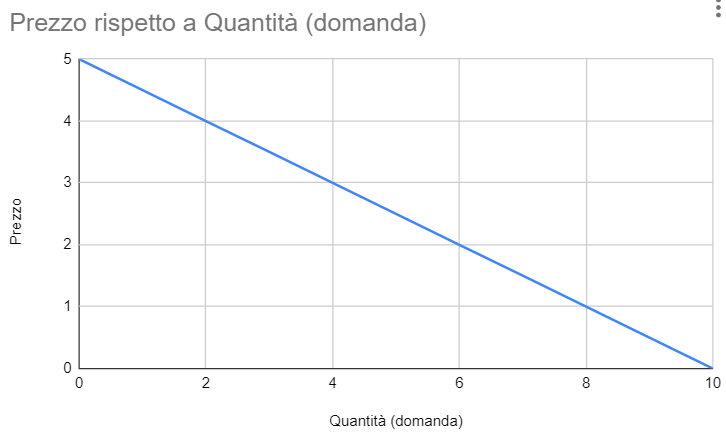
~~~ La versione in italiano inizia subito dopo la versione in inglese ~~~
ENGLISH
21-05-2024 - Principles of economy (1/10) [EN]-[IT]
Business activity
The companies
The activities of a company take place within an economic, social and above all environmental context.
To operate in the market, companies must follow rules and regulations.
To work correctly and profitably, a company must respect the 10 principles of economics:
-Principle 1: Decisions involve choices between alternatives (trade-offs)
-Principle 2: The cost of something is what you have to give up to get it, so-called opportunity cost
-Principle 3: Rational individuals and businesses think at the «margin»
-Principle 4: Individuals and businesses respond to incentives
-Principle 5: Exchange can be beneficial for everyone (Pareto optimal)
-Principle 6: Markets are usually an effective tool for organizing economic activity
-Principle 7: Sometimes state intervention can improve the result produced by the market
-Principle 8: A country's standard of living depends on its capacity to produce goods and services
-Principle 9: Prices rise when the state prints too much money
-Principle 10: Society faces a short-term trade-off between inflation and unemployment.
business decisions
Usually in a company there is always the same universally recognized situation, here it is written below:
Scarce resources and unlimited needs and desires
Economics could be said to be the science of decisions and if we think of a business we immediately think of how many decisions have to be made even just on a daily basis.
PESTLE
When starting a business, or even when a company is well placed in the market, it is always necessary to carry out the PESTLE analysis.
PESTLE analysis takes into account these aspects: political, economic, social, technological, legal and environmental/environmental aspects.
The company moves within these aspects with the objective of maximizing profit.
Economic thinking
At the basis of economic thought is the basic model of supply and demand.
This model is based on some assumptions, and generates
certain conclusions. The analysis of supply and demand is fundamental to understanding the path of a company.
The supply curve is based on the relationship between price and quantity supplied. Where the price is on the ordinate axis and the quantity is on the x axis.
Law of supply
Below is the graph of supply versus price.
We note that the more the quantity increases, the more the price increases, but the ratio is not 1:1. In fact, with quantity 1 the price is 1, but with quantity 3 the price is 2 and with quantity 5 the price is 3. In conclusion, by increasing the quantity of goods produced they can be produced at relatively lower prices.

The market offer
The market offer is nothing more than the sum of the individual offers of the producers.
The offer can increase or decrease in various ways. The aspects can be the following:
-Changes in factor prices: land, labor and capital
-Technology
-Expectations of entrepreneurs or businesses
-The number of sellers on the market
-Social or environmental factors
the law of demand
The demand curve is based on the relationship between price and quantity demanded. Where the price is on the ordinate axis and the quantity is on the x axis. The two terms are inversely related and this is called “the law of demand”.
The graph shows that the lower the price, the more demand increases.

Market equilibrium
The market is said to be in equilibrium when sellers and buyers agree to sell and buy at the same price the quantities that can be sold and purchased at that price.
If there is greater supply than demand at a given price then it is called excess supply.
However, if there is a greater demand than supply at a certain price then it is called excess demand.
The equilibrium can be changed at any time by various events, such as the rise of commodities, political problems or a financial crisis.
For example, an increase in raw materials would raise the price and demand would fall and therefore change the market equilibrium.
Another example could be the occurrence of a financial crisis which would decrease demand and again change the market equilibrium.
The elasticity
Elasticity is something that characterizes the offer.
Price elasticity is said to be elastic if it is sensitive to price and inelastic if it is not sensitive.
Price elasticity of supply formula

Conclusions
Businesses operate in the market by observing laws and rules. The most important law that regulates the market is the law of supply and demand.
Request
Have you ever thought about having your own business to produce goods or services? Or are you already an entrepreneur?

ITALIAN
21-05-2024 - Principles of economy (1/10) [EN]-[IT]
Attività di un’impresa
Le imprese
Le attività di un’impresa si svolgono all’interno di un contesto economico, sociale e soprattutto ambientale.
Le imprese per operare nel mercato devono seguire delle regole e delle normative.
Un impresa per lavorare in maniera corretta e proficua deve rispettare i 10 principi dell'economia:
-Principio 1: Le decisioni comportano scelte fra alternative (trade-off)
-Principio 2: Il costo di qualcosa è ciò a cui si deve rinunciare per ottenerlo, cosiddetto costo opportunità (cost opportunity)
-Principio 3: Gli individui e le imprese razionali pensano al «margine»
-Principio 4: Gli individui e le imprese rispondono agli incentivi
-Principio 5: Lo scambio può essere vantaggioso per tutti (Pareto ottimale)
-Principio 6: I mercati sono di solito uno strumento efficace per organizzare l’attività economica
-Principio 7: A volte l’intervento dello Stato può migliorare il risultato prodotto dal mercato
-Principio 8: Il tenore di vita di un paese dipende dalla sua capacità di produzione di beni e servizi
-Principio 9: I prezzi aumentano quando lo Stato stampa troppa moneta
-Principio 10: La società si confronta con un trade-off di breve periodo tra inflazione e disoccupazione.
decisioni aziendali
Solitamente in un impresa si avverte sempre la solita situazione riconosciuta universalmente, eccola scritta qui di seguito:
Risorse scarse e bisogni e desideri illimitati
L’economia si potrebbe dire che è la scienza delle decisioni e se pensiamo ad un'impresa ci viene subito in mente quante decisioni si devono prendere anche solo giornalmente.
PESTLE
Quando si avvia un'attività, oppure anche quando un impresa è ben inserita nel mercato, bisogna sempre eseguire l'analisi PESTLE.
Analisi PESTLE tiene conto di questi aspetti: aspetti politici, economici, sociali, tecnologici, legali e ambientali/environment.
All'interno di questi aspetti si muove l'impresa che ha come obiettivo di massimizzare il guadagno.
Il pensiero economico
Alla base del pensiero economico c'è il modello base della domanda e dell’offerta.
Questo modello si basa su alcune ipotesi, e genera
determinate conclusioni. L'analisi della domanda e dell'offerta è fondamentale per capire il cammino di un'impresa.
La curva di offerta è basata sulla relazione tra prezzo e quantità offerta. Dove il prezzo è sull’asse delle ordinate e la quantità sull’asse delle ascisse.
Legge dell'offerta
Qui di seguito il grafico dell'offerta rispetto al prezzo.
Notiamo che più aumenta la quantità e più aumenta il prezzo, ma il rapporto non è 1:1. Infatti con la quantità 1 il prezzo è 1, ma con la quantità 3 il prezzo è 2 e con la quantità 5 il prezzo è 3. In conclusione, aumentando la quantità dei beni prodotti li si possono produrre con prezzi relativamente inferiori.

L’offerta del mercato
L’offerta del mercato non è altro che la somma delle offerte individuali dei produttori.
L'offerta può aumentare o diminuire per vari aspetti. Gli aspetti possono essere i seguenti:
-Variazioni dei prezzi dei fattori: terra, lavoro e capitale
-Tecnologia
-Aspettative degli imprenditori o delle imprese
-Il numero dei venditori sul mercato
-Fattori sociali o ambientali
la legge della domanda
La curva di domanda è basata sulla relazione tra prezzo e quantità domandata. Dove il prezzo è sull’asse delle ordinate e la quantità sull’asse delle ascisse. I due termini sono inversamente correlati e questo viene definito “la legge della domanda”.
Il grafico mostra che più il prezzo si abbassa e più aumenta la domanda.

Equilibrio di mercato
Il mercato si dice che è in equilibrio nel momento in cui i venditori ed i compratori accettano di vendere ed acquistare allo stesso prezzo, le quantità che a quel prezzo possono essere vendute ed acquistate.
Nel caso in cui vi fosse maggiore offerta rispetto alla domanda al determinato prezzo allora si parla di eccesso di offerta.
Nel caso in cui invece vi è una richiesta maggiore rispetto all’offerta ad un determinato prezzo allora si parla di eccesso di domanda.
L'equilibrio può essere cambiato in ogni momento da diversi eventi, come l'aumento delle materie prime, problemi politici o una crisi finanziaria.
Ad esempio un aumento delle materie prime farebbe alzare il prezzo e la domanda calerebbe quindi andrebbe a cambiare l'equilibrio di mercato.
Un altro esempio potrebbe essere il verificarsi di una crisi finanziaria che farebbe diminuire la domanda e andrebbe di nuovo a cambiare l'equilibrio di mercato.
L'elasticità
L'elasticità è qualcosa che caratterizza l'offerta.
L’elasticità rispetto al prezzo si dice elastica se è sensibile rispetto al prezzo ed anelastica se invece non è sensibile.
Formula dell'elasticità dell’offerta al prezzo

Conclusioni
Le imprese operano nel mercato osservando leggi e regole. La legge più importante che regola il mercato è la legge della domanda e dell'offerta.
Domanda
Avete mai pensato di avere un'impresa tutta vostra per produrre dei beni o dei servizi? Oppure siete già degli imprenditori?
THE END
Thank you for the lecture. And thank you for providing such opportunity to be educated on the blockchain.
For companies to run productively, they must follow the appropriate rules and principles.
Ho sempre desiderato fare un'attività in outsourcing, mi spiego: potrei andare nelle aziende, prendevo ordini di particolari metalmeccanici e poi li mandavo a fare in officine che già conosco e so che funzionano benissimo, poi farei vai a consegnarli o spediscili per un corriere,
Il profitto in questo tipo di lavoro è buono, NON devi pagare i lavoratori, non devi pagare le bollette dell'acqua o della luce, NON devi pagare l'affitto dei locali, ti rendi conto, molte spese si eliminano, quindi il profitto potrebbe essere considerevole.
A lot of people respond to incentives and that’s why they keep coming back. Incentive is an important aspect of a business
We shouldn’t take it for granted
#hive #posh